You are using an out of date browser. It may not display this or other websites correctly.
You should upgrade or use an alternative browser.
You should upgrade or use an alternative browser.
Military History & Tactics Thread
- Thread starter Friko_Prizm
- Start date
- Status
- Not open for further replies.
Vanguard
Fino alla morte
I've been searching for a podcast channel with a bigger scope for at least year now. Each time I think I've found a credible channel, they turn all 'kangz' and I'm forced to unsub.
The only African people Dan Carlin mentions are the Carthaginians, Namibian, Egyptians and Nubians. The latter three he mentions in the King of kings series.
Do you mean Numidians?? There was no Namibia thousands of years ago.
[Time to revive this thread].
A LOOK INSIDE WEHRMACHT SNIPER SCHOOL IN 1944 -
Background
In summer offensives of Wehrmacht into Soviet Union, Red army snipers proved to be a constant head ache for them. They specifically targeted officers and NCOs. The Wehrmacht lacked professional snipers of it's own but did not feel any need to form dedicated snipers units because of it's superiority in the field, it could tackle red army's snipers by using heavy infantry weapons like mortars and assault cannons. The speed and surprise of Blitzkrieg tactics made them stop thinking about having snipers of their own.
When the tide of the war turned, only then Wehrmacht realized the importance of having snipers and started professional sniper training courses in 1943.

Soviet sniper
German sniper course
Venue
In the last few months of 1943 at large military depots , firing ranges were introduced for sniper training in Germany, Austria, Hungary and Lithuania.
Duration of the course
The course lasted 4 weeks.
Participants of the course
The recruits were veterans who were recognized as either sharpshooters or good prospects along side recent conscripts.
That was considered an advanced course for specialists with no endless shouting, no purposeless drill and no brutal indoctrination of course material by rote.
"Welcome to the course"
The CSM( Company sergeant major) welcomed soldiers with a friendly introductory talk and talk about course accommodation.
Sniper schools had this Gothic lettering nailed to a wall welcoming new trainees:
1. The sniper is the hunter among soldiers!
2. His job is difficult and demands the dedication of body, soul and mind.
3. Only a thoroughly convinced and steadfast soldier can become a sniper.
4. It is only possible to destroy an enemy if one has learnt to hate and persecute him with all the strength in one's soul!
5. A sniper is a man set apart from the common soldier.
6. He fights unseen.
7. His strength is based on Red Indian-like use of territory linked to perfect camouflage, catlike agility and masterly use of his rifle.
8. Awareness of his abilities gives him the sureness and superiority which guarantee success.
The Instructors
The instructors were veteran snipers, who were wounded in the battles and deprived of their " fit for the front " medical category. Many of those who served as instructors in sniper schools had partial invalidities like not having a limb, not having some fingers etc.
Initiation of Sniper's course
Trainees were divided into sub groups of 5 students and each sub group was trained by a separate instructor (usually a sergeant) to guarantee the almost personal transmission of knowledge.
Course started on the next day of arrival of students.
Course began with introduction on telescopic sights.
Weapons
A table top was laid with four rifles, three Mauser K98k and one Walther self-loading Modell 43 (G-43). Each weapon fitted with an optical sight. The Mausers were fitted respectively with the 15cm long Modell 41, the 6-power Zeiss Zielsechs and the Hensoldt Modell Dialytan optical sights. While the walther semi-automatic rifle was fitted with Voigtilander Modell 4 sight.

Mauser K98K with Model 41(ZF41) scope

Mauser k98k with Zeiss ZF42 scope

Mauser K98K with 4x Dialytan scope

Walther 43 semi automatic with Voigtilander Modell 4(ZF4) sight.
Weapon specifications:
Mauser K98K
Cartridge: 7.92x57mm Mauser
Action: Bolt-Action
Muzzle velocity: 760 m/s (2,493 ft/s)
Effective firing range: 500 m (550 yd) with iron sights, 1000 m (1,090 yd) with telescopic sight
Feed system: 5-round stripper clip, internal magazine
Sights: Iron sights or telescopic sights.
Walther 43
Cartridge: 7.92x57mm Mauser
Action: Gas operated
Muzzle velocity: 746–776 m/s (2,448–2,546 ft/s)
Effective firing range: 500 m, 800 m with scope
Feed system: 10-round detachable box magazine, stripper clip fed
Sights: Iron sights, Zf42 optical crosshair sight
"Checking out" weapons
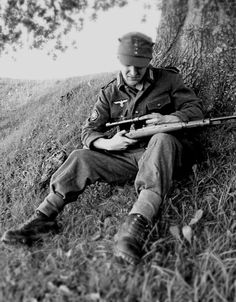
The tutors explained the efficiency of the four optics and mountings, they spoke about the Mauser carbine with Hensoldt sight( Dialytan sight) specifically, this being considered the best and firmest combination, and the rifle with which each every student would be issued. In the afternoon the students range-tested each of the four rifles. The Zeiss and Hensoldt optics offered a wide field of vision, which were far superior to the Russian scope.On the other hand, the latter and the Voigtlander were virtually similar, and although the Walther self-loading rifle was a pleasant weapon to fire, since part of the recoil force was absorbed by the automatic reload mechanism, its accuracy fell short of the Mauser carbine. The semi automatic with ZF-41 sight was not considered to be a good sniper rifle.
Firing practice

After above mentioned free exercises the students returned to ordinary rifle shooting with the conventional K98k carbine over open sights from 50 to 300 metres: free standing, kneeling, lying. Ammunition was made freely available and the usual safety drills were dispensed with to allow the students to keep up the momentum.
Background
In summer offensives of Wehrmacht into Soviet Union, Red army snipers proved to be a constant head ache for them. They specifically targeted officers and NCOs. The Wehrmacht lacked professional snipers of it's own but did not feel any need to form dedicated snipers units because of it's superiority in the field, it could tackle red army's snipers by using heavy infantry weapons like mortars and assault cannons. The speed and surprise of Blitzkrieg tactics made them stop thinking about having snipers of their own.
When the tide of the war turned, only then Wehrmacht realized the importance of having snipers and started professional sniper training courses in 1943.

Soviet sniper
German sniper course
Venue
In the last few months of 1943 at large military depots , firing ranges were introduced for sniper training in Germany, Austria, Hungary and Lithuania.
Duration of the course
The course lasted 4 weeks.
Participants of the course
The recruits were veterans who were recognized as either sharpshooters or good prospects along side recent conscripts.
That was considered an advanced course for specialists with no endless shouting, no purposeless drill and no brutal indoctrination of course material by rote.
"Welcome to the course"
The CSM( Company sergeant major) welcomed soldiers with a friendly introductory talk and talk about course accommodation.
Sniper schools had this Gothic lettering nailed to a wall welcoming new trainees:
1. The sniper is the hunter among soldiers!
2. His job is difficult and demands the dedication of body, soul and mind.
3. Only a thoroughly convinced and steadfast soldier can become a sniper.
4. It is only possible to destroy an enemy if one has learnt to hate and persecute him with all the strength in one's soul!
5. A sniper is a man set apart from the common soldier.
6. He fights unseen.
7. His strength is based on Red Indian-like use of territory linked to perfect camouflage, catlike agility and masterly use of his rifle.
8. Awareness of his abilities gives him the sureness and superiority which guarantee success.
The Instructors
The instructors were veteran snipers, who were wounded in the battles and deprived of their " fit for the front " medical category. Many of those who served as instructors in sniper schools had partial invalidities like not having a limb, not having some fingers etc.
Initiation of Sniper's course
Trainees were divided into sub groups of 5 students and each sub group was trained by a separate instructor (usually a sergeant) to guarantee the almost personal transmission of knowledge.
Course started on the next day of arrival of students.
Course began with introduction on telescopic sights.
Weapons
A table top was laid with four rifles, three Mauser K98k and one Walther self-loading Modell 43 (G-43). Each weapon fitted with an optical sight. The Mausers were fitted respectively with the 15cm long Modell 41, the 6-power Zeiss Zielsechs and the Hensoldt Modell Dialytan optical sights. While the walther semi-automatic rifle was fitted with Voigtilander Modell 4 sight.

Mauser K98K with Model 41(ZF41) scope

Mauser k98k with Zeiss ZF42 scope

Mauser K98K with 4x Dialytan scope

Walther 43 semi automatic with Voigtilander Modell 4(ZF4) sight.
Weapon specifications:
Mauser K98K
Cartridge: 7.92x57mm Mauser
Action: Bolt-Action
Muzzle velocity: 760 m/s (2,493 ft/s)
Effective firing range: 500 m (550 yd) with iron sights, 1000 m (1,090 yd) with telescopic sight
Feed system: 5-round stripper clip, internal magazine
Sights: Iron sights or telescopic sights.
Walther 43
Cartridge: 7.92x57mm Mauser
Action: Gas operated
Muzzle velocity: 746–776 m/s (2,448–2,546 ft/s)
Effective firing range: 500 m, 800 m with scope
Feed system: 10-round detachable box magazine, stripper clip fed
Sights: Iron sights, Zf42 optical crosshair sight
"Checking out" weapons

The tutors explained the efficiency of the four optics and mountings, they spoke about the Mauser carbine with Hensoldt sight( Dialytan sight) specifically, this being considered the best and firmest combination, and the rifle with which each every student would be issued. In the afternoon the students range-tested each of the four rifles. The Zeiss and Hensoldt optics offered a wide field of vision, which were far superior to the Russian scope.On the other hand, the latter and the Voigtlander were virtually similar, and although the Walther self-loading rifle was a pleasant weapon to fire, since part of the recoil force was absorbed by the automatic reload mechanism, its accuracy fell short of the Mauser carbine. The semi automatic with ZF-41 sight was not considered to be a good sniper rifle.
Firing practice

After above mentioned free exercises the students returned to ordinary rifle shooting with the conventional K98k carbine over open sights from 50 to 300 metres: free standing, kneeling, lying. Ammunition was made freely available and the usual safety drills were dispensed with to allow the students to keep up the momentum.
Other tactical exercises ( distance estimation, trench digging and camouflage)
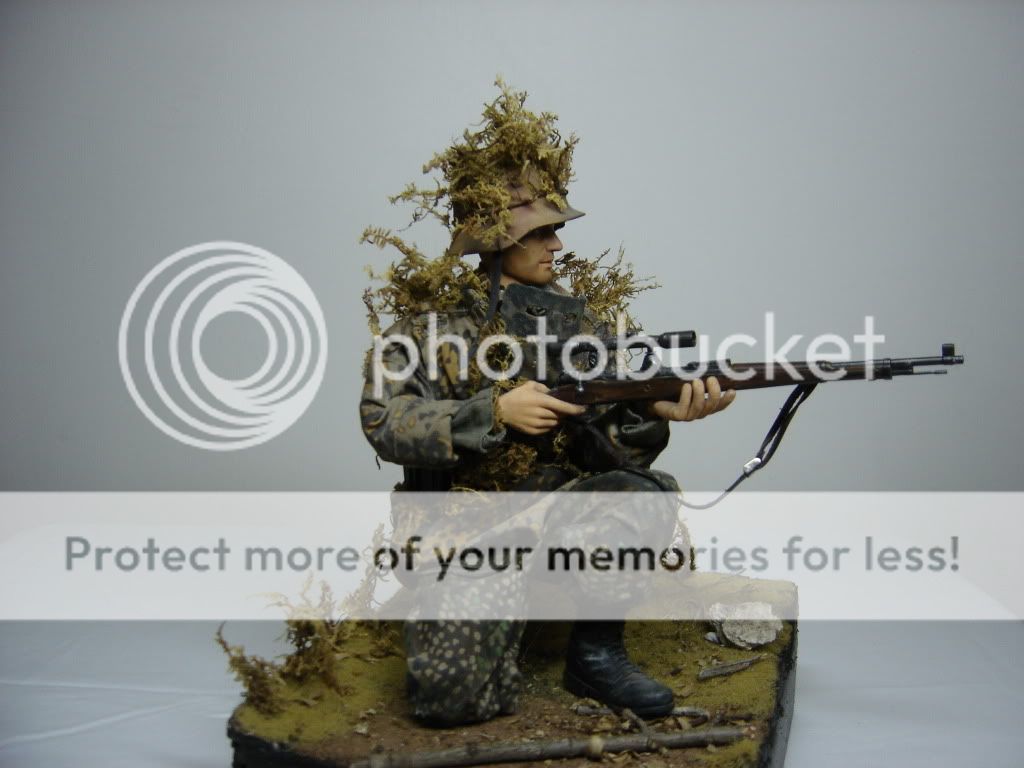
The next day, students were taken to countryside for distance estimation exercises and the tactical assessment of terrain, the afternoon they spent shooting, and in fact there was almost no day in which shooting was absent from the timetable. During the week they were taught trench digging and camouflage. Some of the camouflage ideas were very costly in time and materials, and of questionable value in practice. Hollowed-out tree trunks, a full body camouflage of tree bark, a fake milestone of wood to hide a slit trench: these were ideas that seemed to have no practical value. Practically, camouflage needed to be quickly prepared, effective and improvised from the simplest materials available, limiting the sniper as little as possible in movement.
The "Shooting garden"
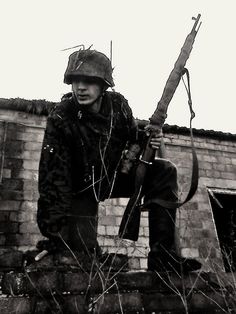
(notice the Mosin Nagant rifle)
On the last day of the first week, students were introduced to "The Shooting Garden". A miniature landscape designed to resemble a valley with roads and a village would be set up at 50 meters from firing range and reduced to scale. Three small-calibre Army sports rifles were provided: the Walther Deutsches Sport Modell with 4-power Oigee sight, the Menz Deutscher Sport and the Gustloff Wehrsportgewehr, the latter two both fitted with the ZF 41 optic.
The exercise was to keep the landscape under observation and shoot at small papier mache figures (dummies) as soon as they appeared at windows, between houses or behind trees. Tiny cars and horse-drawn carts moving across the landscape were also to be brought under fire as the situation demanded. Scoring of students was done in this exercise. Veteran sharpshooters with battle experience achieved perfect score many times which was otherwise a rarity.
The shooting garden received frequent visits from students throughout the course. The arrangement of scenery and location of targets was changed regularly. To encourage competition between the candidates, their daily scores were recorded and the eventual winner received the reward of a certificate and a large sack of groceries. Students were required to keep a small personal notebook to list their scores and jot down observations on the terrain. On the battlefield it was supposed to serve to note their witnessed kills as well. That was to be done by keeping one's name anonymous in actual battlefield because any German soldier who fell into Russian hands and was identified as a sniper could expect to be tortured to death.
Students recieving their wives (Sniper rifles)
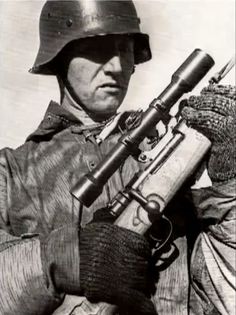
The second week, Students were given brand-new K98k carbines fitted with the 4-power Hensoldt sight on an adjustable mounting. Each man received a personal issue, its registration number being entered into student's individual course books. It would become their personal property upon passing the course successfully. The younger soldiers without battlefield experience were very keen to qualify for this very reason. The weapon was quite a lot shorter than the Russian rifle(Mosin nagant), but the optic was far better.
The first issue of sniper ammunition was distributed from boxes bearing the designation "Anschuss" to distinguish them from ordinary rounds. The instructor told students that the projectiles had been prepared individually to ensure maximum precision. When at the front, students were to ask armourers for them specifically.
Weapon care

The students calibrated the optical sight over a distance of 100 meters. This was done by removing the breech and placing the carbine on sandbags on the range table for stability. When the center of the target was lined up through the barrel, the rifleman coincided the optic by adjusting two screws on the rear foot of the mounting using a special key. After this rough calibration, fine adjustment followed during practical shooting.
Instructions were given never to allow the weapon out of one's hands and throughout the remainder of the course the trainees always carried the weapon with them. All rooms had a rifle keep for use at night. The idea was to instill in students, the need to protect the optic, for any hard jolt could spoil the calibration. Since the calibration procedure had to be repeated if the weapon was knocked or dropped, the culprit was punished with twenty push-ups and thirty knee-bends holding the rifle above his head.
Film sessions

Students were shown a film entitled "Choice of, and Constructing Positions". The film was in Russian with German subtitles and had been recorded in 1935. It gave an impressive insight into the high standard of Russian training. The instructor told the students how difficult Russian snipers had made the advance of German forces in 1941/2. Compared to them, we had known nothing. Our losses among command staff from snipers had been devastating. If a unit lacked heavy infantry weapons, a Russian sniper company could pin it down all day. We had tried to get back on level terms using captured optics. "Ivan has professionals, make no mistake about it, and if you notice that your opposite number is gunning for you, clear out, and never fire a second shot from the same position."
A scene in the film showed a Russian sniper company climbing to the treetops at the edge of a wood. The subtitles read: "Treetops with plenty of leaf are an outstanding position! The rifleman cannot be seen, but has a good view of the landscape and an outstanding field of fire!"
These film sessions were informal and students were at liberty to interject at any time.
Field theory
Field theory was put into practice over the next remaining days to test the independence of the individual. Students were lodged in a common shelter and had to select a suitable spot to dig a personal slit trench for occupation early next morning. The battle scenario was that two enemy snipers had "No-Man's-Land" pinned down: any observed movement of the trainee meant his end, the purpose being to teach him to lie low and consider personal strategy for the next day. Near each sniper was a tutor who refereed on claimed "kills". The trainees were therefore confined to their individual trenches until night fell. To remain more or less immobile in one spot from five in the morning to eleven at night brought with it questions about food, water and the natural functions.The students (usually veterans) who chose and prepared a position that took all this into account passed the test comfortably on the other hand, students who preferred for the most part to cover their helmets with a light camouflage of grass and fresh twigs found themselves in trouble and they, at the end of the exercise would be at their last gasp. Most would have had wet their trousers and worse, attracting the pithy observation of the course tutor: "Men, here's a hot tip, first thing upon rising, empty your bowels", or words to that effect. Next day during the official tour of the trenches students were asked to give the points for and against their own dugouts.
Introducing students to supression
Snipers often moved in No-Man's-Land between the lines. If spotted by the enemy they would be engaged with heavy infantry weapons. In order to judge the correct defensive method, it was an advantage to recognize these weapons by the noise they made when fired. If one came under mortar attack for example, it was only a question of time before the Russians got the range or saturated the area so thoroughly that one could not avoid falling victim. In this case it was essential to leave the trench at once. If one could not retire through cover, the alternative was to jump up suddenly and run in wild zigzags for the German line. Snipers called this the " hare's jump". It required a high degree of composure but offered the only possibility of surviving the situation. Hare's leap was therefore practiced repeatedly in training, yet when the hour came many snipers preferred to remain in their foxholes in a blue funk, and perished.
" While a real mortar could be fired for our instruction, a gramophone record was played for the acoustic demonstration of one of the most feared Soviet weapons, the Stalin organ, a multiple rocket launcher mounted on a lorry ". The full battery would transform a football field into a blizzard of steel splinters and worked earth. The rhythmic, howling noise of discharge played at full volume would make the stomach of the students turn.
The explosive round
To round off, a new kind of infantry ammunition was shown. This was known as the B-bullet, "B" standing for "Beobachtung" or observation. It had been developed originally as a tracer round for calibrating fighter weapons. The round exploded on impact and indicated the accuracy of the burst. Aerial MG-gunners were able to calibrate their weapons relatively quickly using this optical aid. The ammunition was very expensive, however, and its use limited to the purpose for which it was designed. The Russians, on the other hand, had issued it to their troops from the onset of the Barbarossa campaign. It was much feared by the German infantry because of the terrible wounds it inflicted. Russian snipers were particularly keen on it. The Soviets had no compunction in putting it into general use. The munition used in small arms was illegal under the Geneva Convention, but the Russians had obviously waived the right to object and the war was at such a desperate stage for Germans, they felt it justified. During a short demonstration with these bullets, trees 5cm in diameter were felled without difficulty.
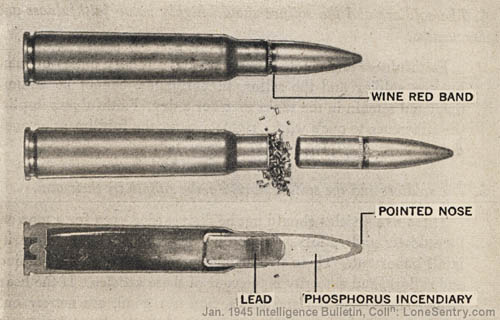
Practical exercises
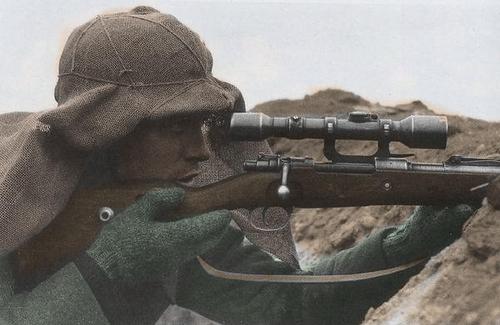
During the last two weeks of instruction, the course concentrated more on the practical. Besides the daily visits to the firing range and the shooting garden, students concentrated on movement in the field, passing unseen through military exercises held by other units, or infiltrating between the lines. Later the principle of the shooting garden was transferred to open terrain and a time limit imposed for spotting and shooting at the papier dummy figures. For failure, points were deducted from the scorecard and "death" awarded. Many inexperienced boys quickly came to understand the dangers of the life they had embraced. When these drills began, they "died" like flies. Yet it was not quite so bad as it looked, for official sniper tactics were permanently offensive while in reality on the battlefield many difficult situations resolved themselves by a healthy dose of caution. A good sniper had to know when it was best to vanish, but the training programme did not teach discretion.

The next day, students were taken to countryside for distance estimation exercises and the tactical assessment of terrain, the afternoon they spent shooting, and in fact there was almost no day in which shooting was absent from the timetable. During the week they were taught trench digging and camouflage. Some of the camouflage ideas were very costly in time and materials, and of questionable value in practice. Hollowed-out tree trunks, a full body camouflage of tree bark, a fake milestone of wood to hide a slit trench: these were ideas that seemed to have no practical value. Practically, camouflage needed to be quickly prepared, effective and improvised from the simplest materials available, limiting the sniper as little as possible in movement.
The "Shooting garden"

(notice the Mosin Nagant rifle)
On the last day of the first week, students were introduced to "The Shooting Garden". A miniature landscape designed to resemble a valley with roads and a village would be set up at 50 meters from firing range and reduced to scale. Three small-calibre Army sports rifles were provided: the Walther Deutsches Sport Modell with 4-power Oigee sight, the Menz Deutscher Sport and the Gustloff Wehrsportgewehr, the latter two both fitted with the ZF 41 optic.
The exercise was to keep the landscape under observation and shoot at small papier mache figures (dummies) as soon as they appeared at windows, between houses or behind trees. Tiny cars and horse-drawn carts moving across the landscape were also to be brought under fire as the situation demanded. Scoring of students was done in this exercise. Veteran sharpshooters with battle experience achieved perfect score many times which was otherwise a rarity.
The shooting garden received frequent visits from students throughout the course. The arrangement of scenery and location of targets was changed regularly. To encourage competition between the candidates, their daily scores were recorded and the eventual winner received the reward of a certificate and a large sack of groceries. Students were required to keep a small personal notebook to list their scores and jot down observations on the terrain. On the battlefield it was supposed to serve to note their witnessed kills as well. That was to be done by keeping one's name anonymous in actual battlefield because any German soldier who fell into Russian hands and was identified as a sniper could expect to be tortured to death.
Students recieving their wives (Sniper rifles)

The second week, Students were given brand-new K98k carbines fitted with the 4-power Hensoldt sight on an adjustable mounting. Each man received a personal issue, its registration number being entered into student's individual course books. It would become their personal property upon passing the course successfully. The younger soldiers without battlefield experience were very keen to qualify for this very reason. The weapon was quite a lot shorter than the Russian rifle(Mosin nagant), but the optic was far better.
The first issue of sniper ammunition was distributed from boxes bearing the designation "Anschuss" to distinguish them from ordinary rounds. The instructor told students that the projectiles had been prepared individually to ensure maximum precision. When at the front, students were to ask armourers for them specifically.
Weapon care

The students calibrated the optical sight over a distance of 100 meters. This was done by removing the breech and placing the carbine on sandbags on the range table for stability. When the center of the target was lined up through the barrel, the rifleman coincided the optic by adjusting two screws on the rear foot of the mounting using a special key. After this rough calibration, fine adjustment followed during practical shooting.
Instructions were given never to allow the weapon out of one's hands and throughout the remainder of the course the trainees always carried the weapon with them. All rooms had a rifle keep for use at night. The idea was to instill in students, the need to protect the optic, for any hard jolt could spoil the calibration. Since the calibration procedure had to be repeated if the weapon was knocked or dropped, the culprit was punished with twenty push-ups and thirty knee-bends holding the rifle above his head.
Film sessions

Students were shown a film entitled "Choice of, and Constructing Positions". The film was in Russian with German subtitles and had been recorded in 1935. It gave an impressive insight into the high standard of Russian training. The instructor told the students how difficult Russian snipers had made the advance of German forces in 1941/2. Compared to them, we had known nothing. Our losses among command staff from snipers had been devastating. If a unit lacked heavy infantry weapons, a Russian sniper company could pin it down all day. We had tried to get back on level terms using captured optics. "Ivan has professionals, make no mistake about it, and if you notice that your opposite number is gunning for you, clear out, and never fire a second shot from the same position."
A scene in the film showed a Russian sniper company climbing to the treetops at the edge of a wood. The subtitles read: "Treetops with plenty of leaf are an outstanding position! The rifleman cannot be seen, but has a good view of the landscape and an outstanding field of fire!"
These film sessions were informal and students were at liberty to interject at any time.
Field theory
Field theory was put into practice over the next remaining days to test the independence of the individual. Students were lodged in a common shelter and had to select a suitable spot to dig a personal slit trench for occupation early next morning. The battle scenario was that two enemy snipers had "No-Man's-Land" pinned down: any observed movement of the trainee meant his end, the purpose being to teach him to lie low and consider personal strategy for the next day. Near each sniper was a tutor who refereed on claimed "kills". The trainees were therefore confined to their individual trenches until night fell. To remain more or less immobile in one spot from five in the morning to eleven at night brought with it questions about food, water and the natural functions.The students (usually veterans) who chose and prepared a position that took all this into account passed the test comfortably on the other hand, students who preferred for the most part to cover their helmets with a light camouflage of grass and fresh twigs found themselves in trouble and they, at the end of the exercise would be at their last gasp. Most would have had wet their trousers and worse, attracting the pithy observation of the course tutor: "Men, here's a hot tip, first thing upon rising, empty your bowels", or words to that effect. Next day during the official tour of the trenches students were asked to give the points for and against their own dugouts.
Introducing students to supression
Snipers often moved in No-Man's-Land between the lines. If spotted by the enemy they would be engaged with heavy infantry weapons. In order to judge the correct defensive method, it was an advantage to recognize these weapons by the noise they made when fired. If one came under mortar attack for example, it was only a question of time before the Russians got the range or saturated the area so thoroughly that one could not avoid falling victim. In this case it was essential to leave the trench at once. If one could not retire through cover, the alternative was to jump up suddenly and run in wild zigzags for the German line. Snipers called this the " hare's jump". It required a high degree of composure but offered the only possibility of surviving the situation. Hare's leap was therefore practiced repeatedly in training, yet when the hour came many snipers preferred to remain in their foxholes in a blue funk, and perished.
" While a real mortar could be fired for our instruction, a gramophone record was played for the acoustic demonstration of one of the most feared Soviet weapons, the Stalin organ, a multiple rocket launcher mounted on a lorry ". The full battery would transform a football field into a blizzard of steel splinters and worked earth. The rhythmic, howling noise of discharge played at full volume would make the stomach of the students turn.
The explosive round
To round off, a new kind of infantry ammunition was shown. This was known as the B-bullet, "B" standing for "Beobachtung" or observation. It had been developed originally as a tracer round for calibrating fighter weapons. The round exploded on impact and indicated the accuracy of the burst. Aerial MG-gunners were able to calibrate their weapons relatively quickly using this optical aid. The ammunition was very expensive, however, and its use limited to the purpose for which it was designed. The Russians, on the other hand, had issued it to their troops from the onset of the Barbarossa campaign. It was much feared by the German infantry because of the terrible wounds it inflicted. Russian snipers were particularly keen on it. The Soviets had no compunction in putting it into general use. The munition used in small arms was illegal under the Geneva Convention, but the Russians had obviously waived the right to object and the war was at such a desperate stage for Germans, they felt it justified. During a short demonstration with these bullets, trees 5cm in diameter were felled without difficulty.

Practical exercises

During the last two weeks of instruction, the course concentrated more on the practical. Besides the daily visits to the firing range and the shooting garden, students concentrated on movement in the field, passing unseen through military exercises held by other units, or infiltrating between the lines. Later the principle of the shooting garden was transferred to open terrain and a time limit imposed for spotting and shooting at the papier dummy figures. For failure, points were deducted from the scorecard and "death" awarded. Many inexperienced boys quickly came to understand the dangers of the life they had embraced. When these drills began, they "died" like flies. Yet it was not quite so bad as it looked, for official sniper tactics were permanently offensive while in reality on the battlefield many difficult situations resolved themselves by a healthy dose of caution. A good sniper had to know when it was best to vanish, but the training programme did not teach discretion.
CONCLUSION OF COURSE :
The course concluded with a celebration party.
Each man was called forward individually, first those who had failed and were being returned to unit, then those who had passed, beginning in reverse order. After a handshake from the CSM, each man received his personal rifle with optic, a Wehr pass (identification book) bearing the registration number of his rifle, a certificate confirming his success and final position in class, and a parchment in Gothic lettering reading:
German Sniper.
Impress upon yourself these ten rules:
1. Fight fanatically! You are a people hunter!
2. Shoot calmly and deliberately, without haste: the hit rewards you!
3. The most deadly opponent is the enemy sniper! Always reckon with him and attempt to outfox him!
4. Never fire more than once from your position!
5. The entrenching tool lengthens your life, trench-digging spares blood!
6. Practise distance estimation constantly.
7. Be a master of camouflage and in use of terrain!
8. Maintain your shooting skills through constant practice even when away from the front!
9. Never let your sniper rifle out of your hand and give it careful upkeep! A perfectly functioning weapon is your strength and safety!
10. After being wounded, your return to the front is preceded by a fresh sniper's course to sharpen your faculties!
Your goal should be the Sniper Badge, awarded to the Best.
(Those who finished the course with good scores, won an ammunition crate full of delicacy's, wine, cigarettes, chocolate, cold meats and so forth.
The act of receiving the rifle with optic made one a sniper officially).
The course concluded with a celebration party.
Each man was called forward individually, first those who had failed and were being returned to unit, then those who had passed, beginning in reverse order. After a handshake from the CSM, each man received his personal rifle with optic, a Wehr pass (identification book) bearing the registration number of his rifle, a certificate confirming his success and final position in class, and a parchment in Gothic lettering reading:
German Sniper.
Impress upon yourself these ten rules:
1. Fight fanatically! You are a people hunter!
2. Shoot calmly and deliberately, without haste: the hit rewards you!
3. The most deadly opponent is the enemy sniper! Always reckon with him and attempt to outfox him!
4. Never fire more than once from your position!
5. The entrenching tool lengthens your life, trench-digging spares blood!
6. Practise distance estimation constantly.
7. Be a master of camouflage and in use of terrain!
8. Maintain your shooting skills through constant practice even when away from the front!
9. Never let your sniper rifle out of your hand and give it careful upkeep! A perfectly functioning weapon is your strength and safety!
10. After being wounded, your return to the front is preceded by a fresh sniper's course to sharpen your faculties!
Your goal should be the Sniper Badge, awarded to the Best.
(Those who finished the course with good scores, won an ammunition crate full of delicacy's, wine, cigarettes, chocolate, cold meats and so forth.
The act of receiving the rifle with optic made one a sniper officially).
Last edited:
~~Original Source~~
A pretty gruesome first hand look.
A pretty gruesome first hand look.
D2HUM8L31NE
I don't care
Damm the CIA , FBI and NSA are on this shit lmfao its good to learn historic tactics please keep going we need more intellectual s
VIETNAM WAR :
TUNNEL RATS
Tunnel rats were US, Australian and Newzelander soldiers who went inside Viet Cong(VC) tunnels to kill any VC inside, gather any Intel, recover arms and finally demolish the tunnels by planting explosives.Their unofficial moto was " Non gratum anus rodentum" in Latin. It meant " Not worth a rat' s @ss". Tunnel ratting required nerves of steel.

Unofficial patch
Tunnels
Tunnels were used by the Vietnamese in their fight for freedom against the French but were largely expanded when the US forces arrived in Vietnam.
Generally there were two types of tunnels.
1- Expident tunnels
These types of tunnels were not complex and were used to ambush US troops and escape safely after attacking enemy.
2- Complex tunnels
These tunnels covered more area and consisted of rooms, resting places,HQ's, storage places, training centers and hospitals connected to entrances by narrow tunnels. These types of tunnels would also offer good protection against bombs.
Tunnels were used by Viet Cong(VC) to act as staging areas for attacks, ambushes, hiding places and escape routes. At times the VC would vacate tunnels but would come later to resume their activities.
Civilians were also used in construction of tunnels.
Apart from VC or North Vietnamese army(NVA) civilians also inhabited the tunnels including women, children,old along with doctors and nurses.
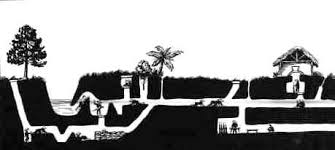
Diagram explaining tunnel systems
The tunnel systems
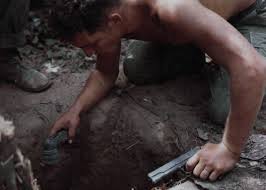
Tunnel rat about to enter a tunnel
Originally the tunnels were started during the war against the French, but which were rapidly expanded upon when the American's arrived. They were constructed by volunteer village labourers using simple hoe's and baskets. The Laterite clay in which the tunnels were dug has a dull reddish appearance and dries rock hard during the dry season. During the wet season it is very soft and much easier to work. Because of the very nature of the Laterite clay's ability to dry rock hard it made a very good (if a somewhat difficult substance to work) soil in which to carve out a tunnel.
The passages themselves were not cut in dead straight lines, rather they were made with corners that had between a 60 - degree and a 120 - degree angle to them. In other words the corners were constructed with no less than a 60 - degree angle and no more than a 120 - degree angle. This made shooting in a straight line impossible, and helped to deflect explosive blasts from grenades that might be thrown down.
The tunnel systems (where the water table permitted) had several levels, each level was separated by a watertight trap door which would seal the rest of the system against gas, flooding, etc. The trap doors themselves were virtually undetectable and could fool a person into believing that the tunnel finished in a dead end, when in reality it led into a huge system of other passages. These passages would in turn lead to underground ammo dumps, kitchens, air raid shelters, hospitals, store rooms, workshops, latrines, and even theatres for the performances of political plays.
All the tunnel systems had smaller thin (drain pipe sized) ventilation shafts leading from the surface down to the 1st level. These vents were constructed with an oblique angle so as to prevent the monsoon rains flooding the system. Vents were placed so as to face east and the light of a new day, whilst others were placed toward the wind so as to provide a constant cooling draught. Despite these efforts the tunnels were still hot, dark, and claustrophobic, even at the best of times.

The VC also dragged the bodies of their dead comrades underground in order to inter them in temporary graves when it became impossible to bury them above ground due to the presence of American/Australian troops. Once they had been dragged underground they were buried in the foetus position in the tunnel walls and covered with a thin layer of clay.
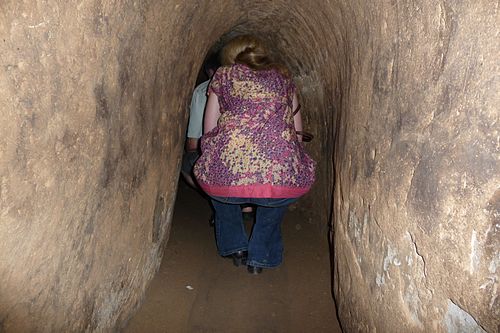
Tourist moving through a pathway in Vietnamese tunnel
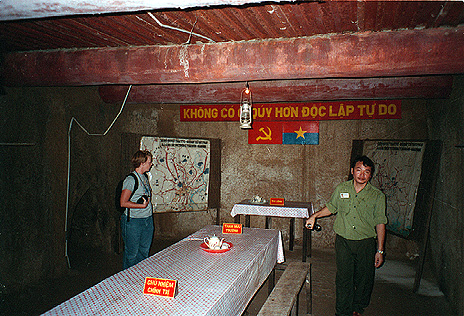
Tourists inside Chu Chi tunnel command centre
Tunnel denial
A detected tunnel would be denied to the enemy. Generally 3 methods of tunnel denial were practiced by US forces.
1- Immediate denial.
In this method, tear gas (CS) would be forced inside a tunnel by grenades or special pump and entrances would be sealed. After some time, the people inside would be forced to come out.
The drawback was that some times tunnels had separate sections within them sealed separately by trap doors and the complex construction of tunnels.
However it was effective method to deal with simple tunnels.
2- Partial denial.
In this method, the tunnel entrances would be sealed by C4 explosives or grenades.
The drawback was that there were several entrances and one could not detect all entrances of a tunnel for sure.
3- Total destruction
In this method, men would be sent inside to recover Intel and arms and map the tunnels and then use C4 explosives,TNT's,dynamites or liquid explosives to totally demolish the tunnels. Initially dogs were sent in tunnels but this practice was abandoned after slaughter of dogs at the hands of VC and booby traps.
The men who went inside came to be known as tunnel rats.
The commander would decide the fate of the tunnels after considering the tactical situation.
Origins
The common practice to deny tunnels to the enemy in US forces was to seal the entrances or throw tear gas inside to force the occupants of the tunnels out.
When the US forces started a massive search and destroy operation against VC (Viet Cong) in the Bo Ho woods, Northwest of Saigon, they suffered serious casualties but the enemy usually disappeared when the US forces gave a chase. It then appeared that the VC were using complex tunnel systems for movements and ambushes.
Sergeant Sweetheart Green of the Australian army gave the VC a chase by entering their tunnels.
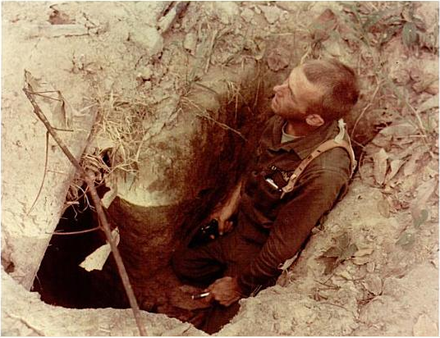
US soldier prepares to enter a tunnel- op crimp
After that, the Australians recovered large caches of weapons and ammunition along with food, documents and Intel.

Australian soldier sitting inside an uncovered tunnel.
TUNNEL RATS
Tunnel rats were US, Australian and Newzelander soldiers who went inside Viet Cong(VC) tunnels to kill any VC inside, gather any Intel, recover arms and finally demolish the tunnels by planting explosives.Their unofficial moto was " Non gratum anus rodentum" in Latin. It meant " Not worth a rat' s @ss". Tunnel ratting required nerves of steel.
Unofficial patch
Tunnels
Tunnels were used by the Vietnamese in their fight for freedom against the French but were largely expanded when the US forces arrived in Vietnam.
Generally there were two types of tunnels.
1- Expident tunnels
These types of tunnels were not complex and were used to ambush US troops and escape safely after attacking enemy.
2- Complex tunnels
These tunnels covered more area and consisted of rooms, resting places,HQ's, storage places, training centers and hospitals connected to entrances by narrow tunnels. These types of tunnels would also offer good protection against bombs.
Tunnels were used by Viet Cong(VC) to act as staging areas for attacks, ambushes, hiding places and escape routes. At times the VC would vacate tunnels but would come later to resume their activities.
Civilians were also used in construction of tunnels.
Apart from VC or North Vietnamese army(NVA) civilians also inhabited the tunnels including women, children,old along with doctors and nurses.
Diagram explaining tunnel systems
The tunnel systems
Tunnel rat about to enter a tunnel
Originally the tunnels were started during the war against the French, but which were rapidly expanded upon when the American's arrived. They were constructed by volunteer village labourers using simple hoe's and baskets. The Laterite clay in which the tunnels were dug has a dull reddish appearance and dries rock hard during the dry season. During the wet season it is very soft and much easier to work. Because of the very nature of the Laterite clay's ability to dry rock hard it made a very good (if a somewhat difficult substance to work) soil in which to carve out a tunnel.
The passages themselves were not cut in dead straight lines, rather they were made with corners that had between a 60 - degree and a 120 - degree angle to them. In other words the corners were constructed with no less than a 60 - degree angle and no more than a 120 - degree angle. This made shooting in a straight line impossible, and helped to deflect explosive blasts from grenades that might be thrown down.
The tunnel systems (where the water table permitted) had several levels, each level was separated by a watertight trap door which would seal the rest of the system against gas, flooding, etc. The trap doors themselves were virtually undetectable and could fool a person into believing that the tunnel finished in a dead end, when in reality it led into a huge system of other passages. These passages would in turn lead to underground ammo dumps, kitchens, air raid shelters, hospitals, store rooms, workshops, latrines, and even theatres for the performances of political plays.
All the tunnel systems had smaller thin (drain pipe sized) ventilation shafts leading from the surface down to the 1st level. These vents were constructed with an oblique angle so as to prevent the monsoon rains flooding the system. Vents were placed so as to face east and the light of a new day, whilst others were placed toward the wind so as to provide a constant cooling draught. Despite these efforts the tunnels were still hot, dark, and claustrophobic, even at the best of times.
The VC also dragged the bodies of their dead comrades underground in order to inter them in temporary graves when it became impossible to bury them above ground due to the presence of American/Australian troops. Once they had been dragged underground they were buried in the foetus position in the tunnel walls and covered with a thin layer of clay.

Tourist moving through a pathway in Vietnamese tunnel

Tourists inside Chu Chi tunnel command centre
Tunnel denial
A detected tunnel would be denied to the enemy. Generally 3 methods of tunnel denial were practiced by US forces.
1- Immediate denial.
In this method, tear gas (CS) would be forced inside a tunnel by grenades or special pump and entrances would be sealed. After some time, the people inside would be forced to come out.
The drawback was that some times tunnels had separate sections within them sealed separately by trap doors and the complex construction of tunnels.
However it was effective method to deal with simple tunnels.
2- Partial denial.
In this method, the tunnel entrances would be sealed by C4 explosives or grenades.
The drawback was that there were several entrances and one could not detect all entrances of a tunnel for sure.
3- Total destruction
In this method, men would be sent inside to recover Intel and arms and map the tunnels and then use C4 explosives,TNT's,dynamites or liquid explosives to totally demolish the tunnels. Initially dogs were sent in tunnels but this practice was abandoned after slaughter of dogs at the hands of VC and booby traps.
The men who went inside came to be known as tunnel rats.
The commander would decide the fate of the tunnels after considering the tactical situation.
Origins
The common practice to deny tunnels to the enemy in US forces was to seal the entrances or throw tear gas inside to force the occupants of the tunnels out.
When the US forces started a massive search and destroy operation against VC (Viet Cong) in the Bo Ho woods, Northwest of Saigon, they suffered serious casualties but the enemy usually disappeared when the US forces gave a chase. It then appeared that the VC were using complex tunnel systems for movements and ambushes.
Sergeant Sweetheart Green of the Australian army gave the VC a chase by entering their tunnels.
US soldier prepares to enter a tunnel- op crimp
After that, the Australians recovered large caches of weapons and ammunition along with food, documents and Intel.
Australian soldier sitting inside an uncovered tunnel.
Physical description of tunnel rats
The tunnel rats were usually men of short stature as they had to crawl into incommodious tunnels.
They were smart and agile.
They at times were bare up their waist.
Weapons and equipments
Because of the tight and cramped up tunnels, tunnel rats avoided arming themselves with regular infantry firearms. Pistol was the primary weapon used by the tunnel rats.
In rare cases though, some tunnel rats carried ak47's, chopped off shotguns(To shorten their length) and even 4 guage shotguns.
Following are the tools of the trade of tunnel rats.
Pistol
Tunnel rats were allowed to carry pistol of their choice. Although the standard issue pistol of US army was the colt1911 .45 calibre but it was usually disliked by the tunnel rats due to it's drawbacks when used within the confines of a tunnel.
Following were the drawbacks of colt1911
One particular favourite pistol of tunnel rats was the .38 Smith and Wesson revolver.
Tunnel rats would often carry Soviet pistols which they found.
Apart from that, .22's, lugers, and walther p38's have also been reportedly carried by tunnel rats. Some tunnel rats used silencers with their pistols to reduce the bark when fired.
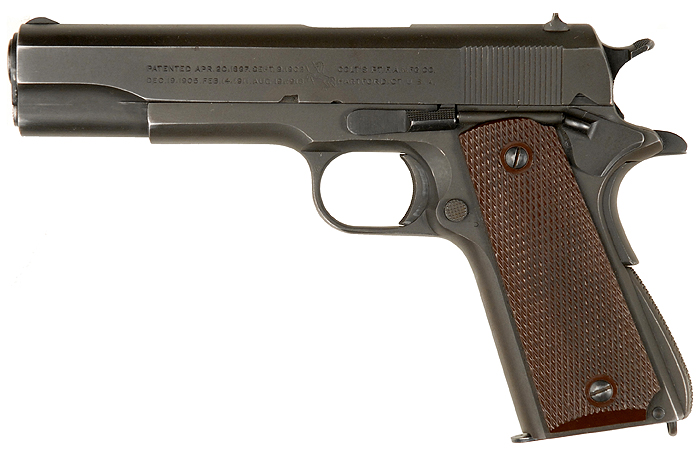
Colt M1911A1 .45
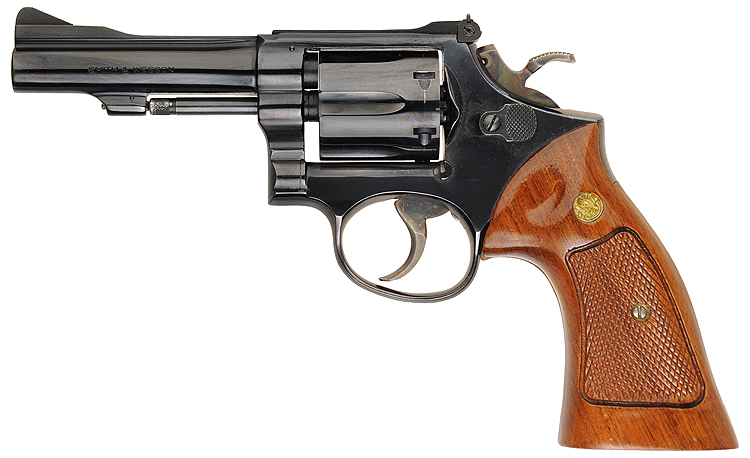
Smith and Wesson model 15 .38
Knife
Apart from pistol, a knife was a must. The tunnel rats carried either an M7 bayonet/knife which was also used as a bayonet on M16 rifle or the KA-Bar knife.
Knives were used for detecting and disabling booby traps, combat and for other purposes like opening crates etc.
 KA- Bar knife with sheath
KA- Bar knife with sheath

M7 bayonet/knife with sheath
Flashlight
Flashlight was a must in the dark tunnels.
Tunnel rats carried the standard issue MX-991 or MX-991U flashlight with them which was "L" shaped. Colored lenses could also be attached to it.
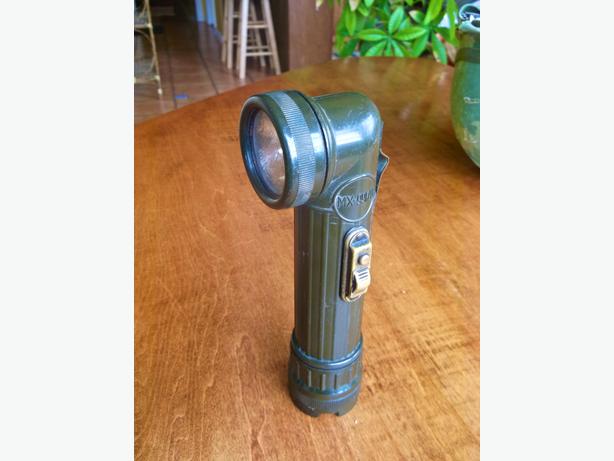
MX-991/U flashlight
Gas mask
Tunnel rats occasionally carried gas masks with them in case CS( tear gas) was used in tunnels. Otherwise they disliked gas masks and preferred to go without them as they limit the field of view of wearer.
The standard issue gas mask were M17 or M17A1 gasmasks.

M17A1 gas mask
CS grenades
Sometimes tunnel rats carried CS or tear gas grenades with them.
The M7A3 was used which is shown below.
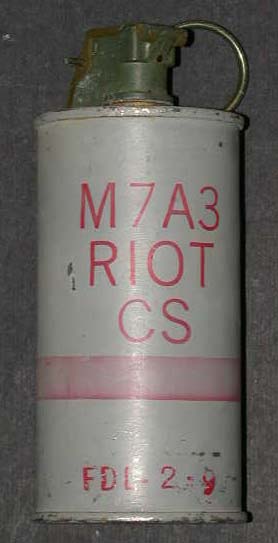
C4 charges
The tunnels were supposed to be demolished after being searched by tunnel rats by means of C4 explosive charges placed at bends and strong points in the tunnel.
The tunnel rats were usually men of short stature as they had to crawl into incommodious tunnels.
They were smart and agile.
They at times were bare up their waist.
Weapons and equipments
Because of the tight and cramped up tunnels, tunnel rats avoided arming themselves with regular infantry firearms. Pistol was the primary weapon used by the tunnel rats.
In rare cases though, some tunnel rats carried ak47's, chopped off shotguns(To shorten their length) and even 4 guage shotguns.
Following are the tools of the trade of tunnel rats.
Pistol
Tunnel rats were allowed to carry pistol of their choice. Although the standard issue pistol of US army was the colt1911 .45 calibre but it was usually disliked by the tunnel rats due to it's drawbacks when used within the confines of a tunnel.
Following were the drawbacks of colt1911
- It was big and heavy(1015 grams)
- It's muzzle blast was intense due to large calibre .45 round, which would leave the user temporarily deaf and unable to hear enemy movements.
- If a silencer was added to reduce the noise signature, then the pistol would become too cumbersome to carry.
One particular favourite pistol of tunnel rats was the .38 Smith and Wesson revolver.
Tunnel rats would often carry Soviet pistols which they found.
Apart from that, .22's, lugers, and walther p38's have also been reportedly carried by tunnel rats. Some tunnel rats used silencers with their pistols to reduce the bark when fired.

Colt M1911A1 .45

Smith and Wesson model 15 .38
Knife
Apart from pistol, a knife was a must. The tunnel rats carried either an M7 bayonet/knife which was also used as a bayonet on M16 rifle or the KA-Bar knife.
Knives were used for detecting and disabling booby traps, combat and for other purposes like opening crates etc.


M7 bayonet/knife with sheath
Flashlight
Flashlight was a must in the dark tunnels.
Tunnel rats carried the standard issue MX-991 or MX-991U flashlight with them which was "L" shaped. Colored lenses could also be attached to it.

MX-991/U flashlight
Gas mask
Tunnel rats occasionally carried gas masks with them in case CS( tear gas) was used in tunnels. Otherwise they disliked gas masks and preferred to go without them as they limit the field of view of wearer.
The standard issue gas mask were M17 or M17A1 gasmasks.

M17A1 gas mask
CS grenades
Sometimes tunnel rats carried CS or tear gas grenades with them.
The M7A3 was used which is shown below.

C4 charges
The tunnels were supposed to be demolished after being searched by tunnel rats by means of C4 explosive charges placed at bends and strong points in the tunnel.
Hazards

Punji trap

Bamboo pit viper

Pressure release trap. There could be rifle, crate or a book in the place of rock.
Tunnel clearing procedure
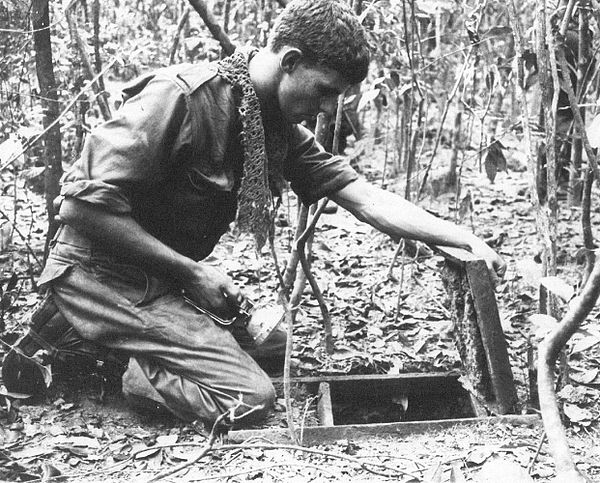
Upon detecting a tunnel entrance, soldiers would check the surrounding area of any booby traps and disarm them if found and a grenade would be thrown inside the tunnel entrance.
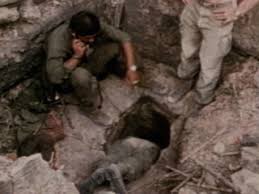
Then the point man would be lowered head first into the tunnel held by his feet by his comrades. He would be holding a pistol in his right hand and a flashlight in left hand. He would see for any enemy and feel the walls and ground for any booby traps and mines. He would be secured by a rope so that he may be pulled out in case of any emergency.The second man would then come inside.
The point man would constantly look for booby traps and enemy activity while the second man would note the soil and amount of overburden which would be later required in demolition calculations.
They would sense for the enemy and alert to movements and sounds like cocking of weapon or sound of grenade pin being pulled.
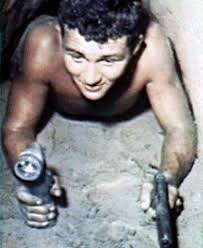
They would kill the enemies and were instructed not to fire 5-6 shots in a row as it would tell the enemy that tunnel rats were about to reload.
They would then search the tunnel for S2 intelligence, maps and documents and would recover any arms and ammunition found in tunnels.
After searching the tunnel and getting out, they would get in again with C4 explosive charges which would be placed at tunnel bends and at strong points in calculated amounts. After getting out and at a safe distance, they would detonate the charges and hence demolish the tunnel.

Things would not go as hoped always because of the unpredictability of the layout of tunnels.
In many cases, VC after knowing that their tunnels have been detected would vacate for example, in one incident, 6 tunnels were found in the outskirts of Saigon, tunnel rats went in and found that the VC have left.
- Booby traps. Pressure release bombs, punji stakes, snake traps( VC would tie a deadly bamboo pit viper which has a hemotoxin venom to ceilings,bushes so that they bite an unaware enemy in the neck, face or hands. VC would also hide snakes in sacks, crates etc).
- Mines.
- Enemy combatants.
- Ambushes. Apart from regular ambushes, some tunnels had special holes in the walls for VC to thrust stakes through them and impale any intruder. Sometimes VC would lay in wait on trap doors and entrances and wait for soldier to emerge and then kill them with stakes, shots, knives.
- Getting lost in the tunnels.
- Non fatal dangers included bat swarms, spiders and the notorious Vietnamese fire ants.

Punji trap

Bamboo pit viper
Pressure release trap. There could be rifle, crate or a book in the place of rock.
Tunnel clearing procedure

Upon detecting a tunnel entrance, soldiers would check the surrounding area of any booby traps and disarm them if found and a grenade would be thrown inside the tunnel entrance.
Then the point man would be lowered head first into the tunnel held by his feet by his comrades. He would be holding a pistol in his right hand and a flashlight in left hand. He would see for any enemy and feel the walls and ground for any booby traps and mines. He would be secured by a rope so that he may be pulled out in case of any emergency.The second man would then come inside.
The point man would constantly look for booby traps and enemy activity while the second man would note the soil and amount of overburden which would be later required in demolition calculations.
They would sense for the enemy and alert to movements and sounds like cocking of weapon or sound of grenade pin being pulled.
They would kill the enemies and were instructed not to fire 5-6 shots in a row as it would tell the enemy that tunnel rats were about to reload.
They would then search the tunnel for S2 intelligence, maps and documents and would recover any arms and ammunition found in tunnels.
After searching the tunnel and getting out, they would get in again with C4 explosive charges which would be placed at tunnel bends and at strong points in calculated amounts. After getting out and at a safe distance, they would detonate the charges and hence demolish the tunnel.
Things would not go as hoped always because of the unpredictability of the layout of tunnels.
In many cases, VC after knowing that their tunnels have been detected would vacate for example, in one incident, 6 tunnels were found in the outskirts of Saigon, tunnel rats went in and found that the VC have left.
Note -
Eardrum perforation was another common injury sustained by tunnel rats because of high caliber .45 shots they fired or the explosives that were placed in tunnels.
Eardrum perforation was another common injury sustained by tunnel rats because of high caliber .45 shots they fired or the explosives that were placed in tunnels.
RasCanjero-
Self imposed exile
@Friko_Prizm great thread. Lol btw you do know that you're on a list now right?
@Friko_Prizm great thread. Lol btw you do know that you're on a list now right?
Thanks sxb
Now who's list may that be?
RasCanjero-
Self imposed exile
Thanks sxb
Now who's list may that be?
NSA, CIA, BSA etc.
RasCanjero-
Self imposed exile
What's the best way to take out a guerrilla force hiding in a landscape similar to South Somalia (arid plains with scattered villages)?
NSA, CIA, BSA etc.
What's the best way to take out a guerrilla force hiding in a landscape similar to South Somalia (arid plains with scattered villages)?
I'd say an effective helicopter operations.
With an excellent intelligence network .
RasCanjero-
Self imposed exile
I'd say effective helicopter operations.
Let's say you didn't have them.
Let's limit the resources to armored vehicles and khat fuelled soldiers armed with ak47s and basic equipment.
You have the Intel of enemy locations and numbers .
Let's say you didn't have them.
Let's limit the resources to armored vehicles and khat fuelled soldiers armed with ak47s and basic equipment.
You have the Intel of enemy locations and numbers .
Prep an ambush.
Setting up an ambush is a difficult task so there's a lot you'll need to consider before you pull off an ambush.
- Timing.
- Forces. To suceed.
- Split your team. You need at least one group that executes the attack and another that will provide cover.
- Scouts.
- Location. Very important! Choose a place for your ambush where the target has to slow down (sharp bends, uphill). The place also must provide you with enough cover so you can’t be seen by your target or other vehicles which might pass by. And of course, you need to be covered from enemy fire as well: Especially your cover fire team needs to have a good spot. You also must be able to withdraw safely from your ambush after the attack.
- Reassembly point.
- Everybody in your team has to know his job:
- Speed is everything. You have to surprise your enemy. Go in, shoot everybody.
- Retreat.
- Regroup at the reassembly point. and assess the situation.
Last edited:
- Status
- Not open for further replies.
Trending
-
From Somali Shaax to Caffeine Cult - my mother's disappointment in me
- Started by Yaraye
- Replies: 28
-
-
Latest posts
-
-
From Somali Shaax to Caffeine Cult - my mother's disappointment in me
- Latest: bobby_hill-Punt
-

